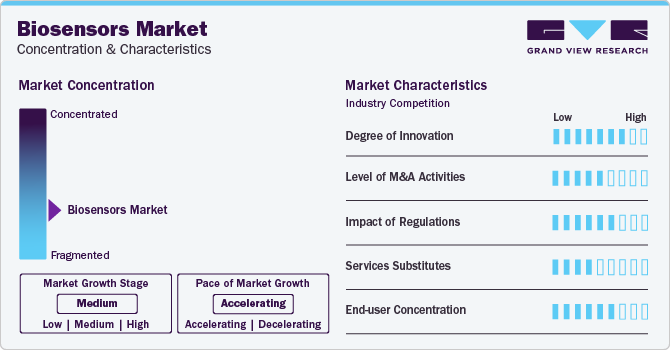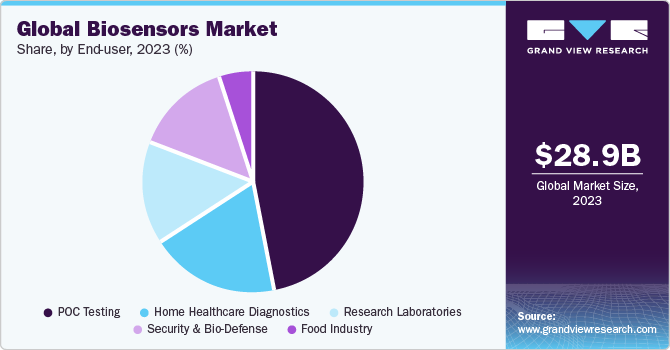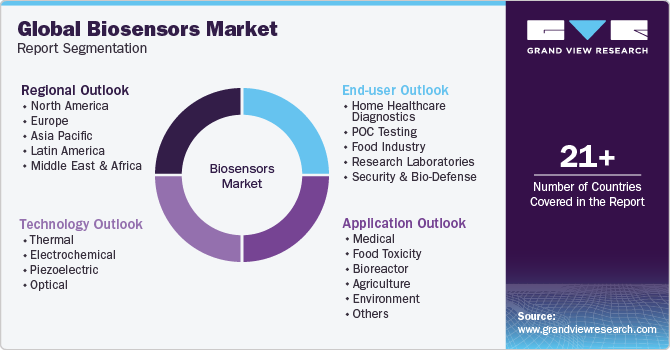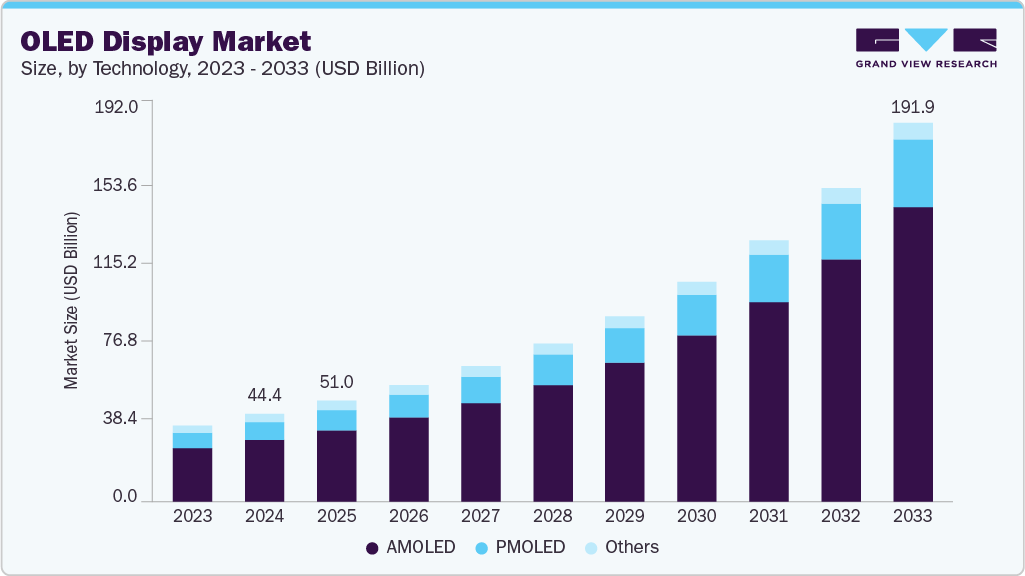- Home
- »
- Medical Devices
- »
-
Biosensors Market Size, Share And Trends Report, 2030GVR Report cover
![Biosensors Market Size, Share & Trends Report]()
Biosensors Market (2025 - 2030) Size, Share & Trends Analysis Report By Technology (Electrochemical, Thermal, Piezoelectric), By Application By End-user, And Segment Forecasts
- Report ID: 978-1-68038-321-8
- Number of Report Pages: 110
- Format: PDF
- Historical Range: 2018 - 2023
- Forecast Period: 2025 - 2030
- Industry: Healthcare
- Report Summary
- Table of Contents
- Interactive Charts
- Methodology
- Download FREE Sample
-
Download Sample Report
Biosensors Market Summary
The global biosensors market size was estimated at USD 30.0 billion in 2024 and is projected to reach USD 48.6 billion by 2030, growing at a compound annual growth rate (CAGR) of 8.6% from 2025 to 2030. The demand for biosensors is increasing due to the diversity of medical applications, increasing number of diabetic patients, high demand for compact diagnostic devices, and rapid technological improvement.
Key Market Trends & Insights
- North America held the largest share of more than 40.2% of the revenue in 2024.
- Asia Pacific is expected to witness the fastest CAGR of 9.9% from 2025 to 2030.
- Based on technology, the electrochemical segment captured the largest market share of around 71.7% in 2024.
- In terms of applications, in 2024, the medical segment dominated the industry and accounted for around 66.8% of the total revenue share.
- Based on end-user, biosensors in point-of-care testing led the market in 2024 accounting for a revenue share of 47.9%.
Market Size & Forecast
- 2024 Market Size: USD 30.0 billion
- 2030 Projected Market Size: USD 48.6 billion
- CAGR (2025-2030): 8.6%
- North America: Largest market in 2024
- Asia Pacific: Fastest growing market
Accurate early diagnosis of the disease is critical to a positive disease prognosis and patient survival. Demand for disposable, convenient, and economical devices with fast response times has increased dramatically in recent years. The emergence of COVID-19 had a positive impact on the medical device industry. Early symptoms of COVID-19 were scanned using a variety of methods. The biosensors market is on the verge of substantial expansion, driven by noteworthy technological advancements and strategic endeavors by key market players. For instance, in January 2023, Intricon, a developer and manufacturer of medical devices leveraging smart miniaturized electronics, made a significant stride by inaugurating a Biosensors Center of Excellence (CoE).
This strategic move highlights Intricon's commitment to integrating its expertise and capabilities in a vertically integrated business unit devoted to introducing biosensor devices to the medical market. Combining technological innovation with a specific focus drives positive growth in the biosensors market.
Nanotechnology-based biosensors are expected to have wide application scope in various industries, such as food analysis, imaging, and microbial activity monitoring. The global market is consolidating due to the growing preference for non-invasive biosensors, rising popularity of medical devices & specialty drugs, and increasing research collaborations & contracts between various manufacturers. For example, Ethicon Endo-Surgery Inc.under contracts administered by Johnson & Johnson Innovation. Another important factor boostingindustry growth is the rising awareness about continuous health monitoring. As a result, the interest of athletes is increasing. Many athletes use Electromyography (EMG) biosensors to keep a close eye on their health and get alerts if something goes wrong.
This early detection can help athletes perform better and stay ahead of their competition. For example, in December 2022, biosensor company Nix launched its first consumer product, Nix Hydration Biosensor. The Hydration Nix Biosensor consists of a Bluetooth-enabled reusable module, a mobile app, and a single-use patch.Despite these considerations, the global market is expected to be constrained by strict regulations and complex cost recovery policies in the global healthcare sector. In addition, existing regulations are slow to adapt to new technologies, hindering product adoption and limiting industry development. The global biosensors market growth is projected to be driven by government programmes focused on the development of proteomics and genomics.
National Information and Communication Technology Australia (NICTA), for example, is projected to expand its data mining, networks, and embedded systems research in this subject. The majority of IT firms are also heavily investing in this sector. Market growth is also driven by investments from major IT companies, such as IBM, Infosys, and TCS. Furthermore, the Chinese government is heavily investing in its computing infrastructure, primarily through the China Grid, which was launched by the Chinese Academy of Sciences, the Ministry of Education, and the China National Grid (CNGrid), supported by the Ministry of Science & Technology. The presence of such beneficial initiatives is projected to boost the market growth.
However, the biosensors market encounters significant challenges, including the necessity for developing compatible single-task tools alongside existing software. The market growth is hindered by a substantial volume of data lacking standardization, impeding seamless integration. There is a crucial demand for user-friendly databases to streamline the analysis of extensive data held by institutions and governments globally, reducing both effort and time.
Market Concentration & Characteristics
Biosensors have made rapid advances in the medical field due to their ability to meet various criteria through a combination of interdisciplinary approaches in chemistry, nanotechnology, and medicine. The market growth is influenced by a number of factors that affect industry dynamics in both positive and negative ways. Furthermore, consumers are being urged to use biosensors for regular detection of pathogenic activities in the body due to the prevalence of chronic and lifestyle-related ailments, which is projected to drive product demand.

The application of biosensors is increasing due to growing elderly population worldwide and availability & affordability in conducting diagnostic tests. Diagnostic laboratories require various skills to test hundreds of samples per day; thus, the introduction of new-age biosensors will drive segment growth. For instance, in January 2023, researchers from the National Institute of Standards and Technology (NIST), Brown University, and CEA-Leti developed a diagnostic biosensor chip to offer accurate and inexpensive DNA biomarker identification. The key differential in the biomarker chip is its modular design, which allows manufacturers to lower the manufacturing cost.
Technology Insights
Based on technology, the industry is categorized into piezoelectric, electrochemical, thermal, and optical. The electrochemical segment captured the largest market share of around 71.7% in 2024 and is expected to grow at the fastest CAGR of 8.7% from 2025 to 2030. This is due to its ubiquitous use in biochemical and biological processes for measurement and analysis. Low detection limits, wide linear response range, excellent stability, and repeatability are all advantages of electrochemical biosensors. Electrochemical detection has a number of advantages over piezoelectric, thermal, and optical detection, resulting in higher market penetration and consumption.
Robustness, compatibility with new microfabrication technologies, ease of operation, low cost, disposability, independence from sample turbidity, and low power needs are among a few benefits. The optical segment is expected to witness significant CAGR from 2025 to 2030. The need for optical biosensors in the analysis is predicted to increase throughout the forecast period owing to their broad analytical coverage. Receptor-cell interactions, fermentation monitoring, structural research, concentration, kinetic, and equilibrium analyses are all possible with optical biosensors. The market for optical biosensors is expected to grow as a result of these factors.
Application Insights
Based on applications, the industry is segmented into bioreactor, medical, agriculture, environment, food toxicity, and others. In 2024, the medical segment dominated the industry and accounted for around 66.8% of the total revenue share. Biosensors are used in the fields of cholesterol testing, blood glucose monitoring, drug discovery, pregnancy testing, blood gas analyzer, and infectious disorders in the medical segment. It is regarded as a vital instrument in the identification and monitoring of a wide range of medical diseases, including diabetes and cancer.The agriculture segment will register the fastest CAGR of 9.8% from 2025 to 2030.
In comparison to traditional techniques used to prevent the loss of livestock and crops due to natural threats and bioterrorism, biosensors allow rapid and specific identification of numerous funguses. Pesticides, heavy metals, and herbicides, as well as pesticides in the ground and soil water, are measured with this instrument. These are also utilized to predict the emergence of soil disease, which was previously impossible with conventional technology, and thus, provide dependable, improved methods for soil disease cleanup and prevention at an early stage. These factors boost the market’s expansion.
End-user Insights
The end-user segment includes research laboratories, the food industry, home healthcare diagnostics and security POC testing, and bio-defense. Biosensors in point-of-care testing led the market in 2024 accounting for a revenue share of 47.9%. Key factors driving the segment growth include technological advancements that create innovative products, such as ultra-sensitive printable biosensors for PoC applications that help detect or monitor organic fluids like urine, saliva, blood, and sweat.

For instance, in August 2022, NanoDx, Inc., a developer of innovative medical diagnostic solutions, and SkyWater Technology announced the first commercially available protein-responsive nano biosensor. The food industry segment is anticipated to witness the fastest CAGR of 9.5% from 2025 to 2030. Its capacity to tackle many issues in the food processing sector, such as minimizing expenses incurred during hygiene analysis by precise tests and offering speedy findings, are key elements contributing to its rapid growth. There are some potential application areas of biosensors in the food industry including fast analysis of food to keep the product freshness and raw material inspections on a regular basis.
Regional Insights
North America held the largest share of more than 40.2% of the revenue in 2024 owing to the presence of key players and high incidence of targeted diseases in the region. Over the projected period, technological improvements, such as the introduction of miniaturized diagnostic equipment that provides increased market penetration of Electronic Medical Records (EMR), as well as precise & quick findings, are expected to fuel market expansion. Furthermore, the Clean Air Act, Clean Water Act, and National Environmental Policy Act all exist in the U.S. and are projected to create growth possibilities for the regional market.

Asia Pacific is expected to witness the fastest CAGR of 9.9% from 2025 to 2030. The presence of significant unmet medical requirements for target diseases, such as cancer, diabetes, and other infectious diseases, as well as continuously improving healthcare expenditure in the region and increasing patient awareness, drive the regional market growth. Increasing demand for home healthcare, PoC, and other healthcare businesses serving the adult population and government efforts to reduce hospital stays through the creation of outpatient care models are likely to drive market growth.
Key Biosensors Company Insights
The market is highly competitive. Key players focus on various strategic initiatives, such as new product launches, geographical expansions, mergers & acquisitions, collaborations, product upgradations, and partnerships, to gain higher industry share.
Some of the key players operating in the market include Bio-Rad Laboratories Inc.; Medtronic; Abbott Laboratories; Biosensors International Group, Ltd.; Johnson & Johnson; Koninklijke Philips N.V.; Nova Biomedical; and Siemens Healthcare.
-
Medtronic is a global health solutions company engaged in the development, manufacturing, distribution, and commercialization of device-based medical therapies and services. Organized into four segments-minimally invasive therapies, cardiac & vascular group, restorative therapies, and diabetes group-Medtronic operates globally with a presence in over 370 locations across approximately 160 countries. The company's products find applications in surgical centers, hospitals, home care, and long-term care facilities. Medtronic utilizes direct representatives in the U.S. and employs independent distributors and direct marketing methods in international markets to market its diverse range of medical solutions.
-
Abbott is a prominent global healthcare company dedicated to the development, manufacturing, and commercialization of healthcare products worldwide. The company operates through four key segments: pharmaceutical products, diagnostic products, nutritional products, and medical devices. Additionally, Abbott is a leading provider of blood glucose monitoring systems. With a widespread global presence, Abbott conducts operations in over 160 countries, emphasizing its commitment to addressing healthcare needs on a global scale. Notably, Abbott's subsidiary, St. Jude Medical, contributes to the company's diverse portfolio and overall impact in the healthcare industry.
Key Biosensors Companies:
The following are the leading companies in the biosensors market. These companies collectively hold the largest market share and dictate industry trends. Financials, strategy maps & products of these biosensors companies are analyzed to map the supply network.
- Abbott Laboratories
- Medtronic
- Biosensors International Group
- Pinnacle Technology, Inc.
- Dupont.
- Sensirion AG
- Thermo Fisher Scientific, Inc.
- F. Hoffmann-La Roche AG
- Siemens Healthineers
- Zimmer & Peacock AS
- Metrohm AG
- DexCom, Inc.
- Universal Biosensors, Inc.
- Johnson & Johnson Services, Inc.
- Nix Biosensors
- Cyrcadia Health
- Lifescan
Recent Developments
- In January 2023, Intricon Corporation announced the opening of a Bionsensor Center of Excellence (CoE). The center aims to vertically integrate the company’s business to provide biosensors in medical devices.
Biosensors Market Report Scope
Report Attribute
Details
Market size value in 2025
USD 32.2 billion
Revenue forecast in 2030
USD 48.6 billion
Growth rate
CAGR of 8.6% from 2025 to 2030
Actual data
2018 - 2023
Forecast period
2025 - 2030
Quantitative units
Revenue in USD million/billion, volume in unit, and CAGR from 2025 to 2030
Report coverage
Revenue forecast, company ranking, competitive landscape, growth factors, and trends
Segments covered
Technology, application, end-user, region
Regional scope
North America; Europe; Asia Pacific; Latin America; MEA
Country scope
U.S.; Canada; UK; Germany; France; Italy; Spain; Sweden; Norway; Denmark; Japan; China; India; Australia; South Korea; Thailand; Brazil; Mexico; Argentina; South Africa; Saudi Arabia; UAE; Kuwait
Key companies profiled
Abbott Laboratories; Medtronic; Biosensors International Group; Pinnacle Technology, Inc.; Dupont. ; Sensirion AG; Thermo Fisher Scientific, Inc.; F. Hoffmann-La Roche AG; Siemens Healthineers; Zimmer & Peacock AS; Metrohm AG; DexCom, Inc.; Universal Biosensors, Inc.; Johnson & Johnson Services, Inc.; Nix Biosensors; Cyrcadia Health; Lifescan
Customization scope
Free report customization (equivalent up to 8 analysts working days) with purchase. Addition or alteration to country, regional & segment scope
Pricing and purchase options
Avail customized purchase options to meet your exact research needs. Explore purchase options
Global Biosensors Market Report Segmentation
This report forecasts revenue growth at global, regional, and country levels and provides an analysis of the latest trends in each of the sub-segments from 2018 to 2030. For this study, Grand View Research has segmented the biosensors market report on the basis of technology, application, end-user, and region:

-
Technology Outlook (Volume, Unit; Revenue, USD Million, 2018 - 2030)
-
Thermal
-
Electrochemical
-
Piezoelectric
-
Optical
-
-
Application Outlook (Volume, Unit; Revenue, USD Million, 2018 - 2030)
-
Medical
-
Cholesterol
-
Blood Glucose
-
Blood Gas Analyzer
-
Pregnancy Testing
-
Drug Discovery
-
Infectious Disease
-
-
Food Toxicity
-
Bioreactor
-
Agriculture
-
Environment
-
Others
-
-
End-user Outlook (Volume, Unit; Revenue, USD Million, 2018 - 2030)
-
Home Healthcare Diagnostics
-
POC Testing
-
Food Industry
-
Research Laboratories
-
Security and Bio-Defense
-
-
Regional Outlook (Volume, Unit; Revenue, USD Million, 2018 - 2030)
-
North America
-
U.S.
-
Canada
-
-
Europe
-
UK
-
Germany
-
France
-
Italy
-
Spain
-
Denmark
-
Sweden
-
Norway
-
-
Asia Pacific
-
Japan
-
China
-
India
-
Australia
-
South Korea
-
Thailand
-
-
Latin America
-
Brazil
-
Mexico
-
Argentina
-
-
Middle East and Africa (MEA)
-
South Africa
-
Saudi Arabia
-
UAE
-
Kuwait
-
-
Frequently Asked Questions About This Report
b. The global biosensors market size was estimated at USD 30.0 billion in 2024 and is expected to reach USD 32.2 billion in 2025.
b. The global biosensors market is expected to grow at a compound annual growth rate of 8.6% from 2025 to 2030 to reach USD 48.6 billion by 2030.
b. The electrochemical segment dominated the global biosensors market and accounted for the largest revenue share of 71.7% in 2024.
b. The POC testing segment dominated the global biosensors market and accounted for the largest revenue share of around 47.9% in 2024.
b. The medical segment dominated the global biosensors market and accounted for the largest revenue share of 66.8%.
Share this report with your colleague or friend.
Need a Tailored Report?
Customize this report to your needs — add regions, segments, or data points, with 20% free customization.

ISO 9001:2015 & 27001:2022 Certified
We are GDPR and CCPA compliant! Your transaction & personal information is safe and secure. For more details, please read our privacy policy.
Trusted market insights - try a free sample
See how our reports are structured and why industry leaders rely on Grand View Research. Get a free sample or ask us to tailor this report to your needs.










